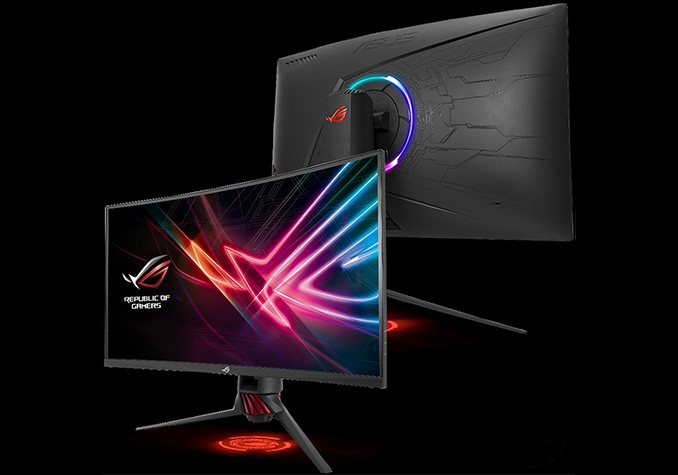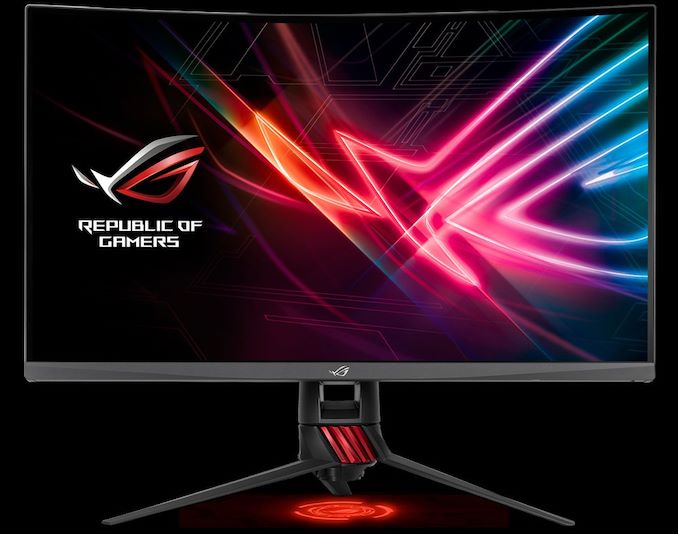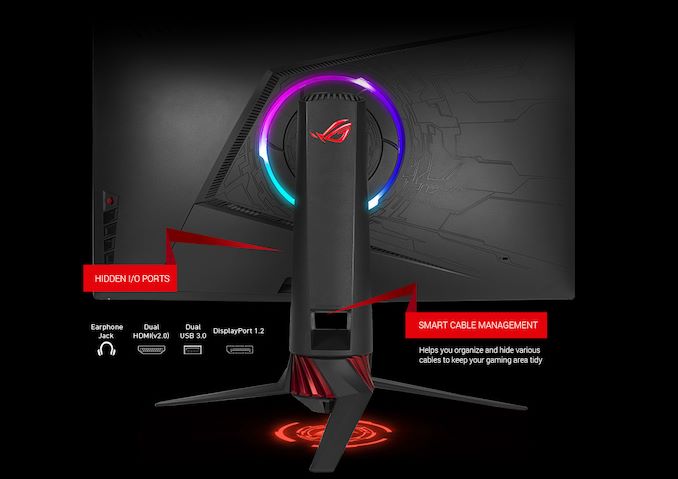ASUS Lists ROG Strix XG32VQR Curved FreeSync 2 Display with RGB
by Anton Shilov on November 30, 2018 3:00 PM EST
ASUS has quietly added its first AMD FreeSync 2-supporting monitor to its lineup. The ROG Strix XG32VQR is a large curved display boasting with a 144 Hz maximum refresh rate, the DisplayHDR 400 badge, and is capable of covering 94% of the the DCI-P3 color gamut. The LCD will be the sixth FreeSync 2 monitor on the market, so it will have only a limited number of competitors. Meanwhile, one of its ways to attract attention of gamers will be its Aura Sync RGB lighting.
Specifications of the ASUS ROG Strix XG32VQR are generally similar to specs of other FreeSync 2 displays introduced by competing manufacturers this year, but there are a number of important improvements that the ASUS product offers. The monitor uses a 31.5-inch curved VA panel featuring a 2560×1440 resolution, 450 nits brightness (by contrast, competing displays only offer 400 nits brightness), a 3000:1 contrast ratio, 178°/178° viewing angles, a 4 ms response time, and a 144 Hz maximum refresh rate. The LCD can reproduce 94% of the DCI-P3 color gamut as well as 125% of the sRGB color space (keep in mind that everything higher than 100% in case of color spaces is a rather uncertain advantage).
Meanwhile, the main features of the ROG Strix XG32VQR are AMD’s FreeSync 2 dynamic refresh rate technology with Low Framerate Compensation tech as well as the DisplayHDR 400 badge. The FreeSync 2 range that ASUS offers is between 48 Hz and 144 Hz, which is broader than that offered by competing displays supporting the tech (from 72 Hz to 144 Hz).
Speaking of competitors, it is necessary to note that apart from higher luminance and broader FS2 range, the ROG Strix XG32VQR features ASUS Aura RGB lighting on the back as well as an LED-based ROG signature on the bottom. RGB and lighting effects are quite trendy among gaming community these days, so these features will clearly attract attention of the target audience.
Other capabilities that will be appreciated by gamers include firmware-based GamePlus and GameVisual technologies that add elements like crosshair or FPS counter as well as adjust brightness and contrast settings for particular game genres.
Moving on to connectivity, the display is equipped with DisplayPort 1.2, Mini DisplayPort 1.2, and HDMI 2.0 inputs. The monitor also sporots a dual-port USB 3.0 hub and a headphone jack. In addition, the monitor has an adjustable stand that can regulate height, tilt, and swivel.
ASUS has not announced pricing of the monitor or its availability timeframe. Considering the fact that a number of companies already offer similar devices, it is highly likely that the ROG Strix XG32VQR will hit the market sooner rather than later.
| The ASUS ROG Strix XG32VQR | |
| General Specifications | |
| Panel | 31.5" VA |
| Native Resolution | 2560 × 1440 |
| Maximum Refresh Rate | 144 Hz |
| Response Time | 4 ms GtG |
| Brightness | 450 cd/m² (peak) |
| Contrast | 3000:1 |
| Backlighting | LED |
| Viewing Angles | 178°/178° horizontal/vertical |
| Curvature | 1800R |
| Aspect Ratio | 16:9 |
| Color Gamut | 125% sRGB/BT.709 94% DCI-P3 |
| DisplayHDR Tier | 400 |
| Dynamic Refresh Rate Tech | AMD FreeSync 2 (48 - 144 Hz) |
| Pixel Pitch | 0.2767 mm² |
| Pixel Density | 91.79 PPI |
| Inputs | 1 × DisplayPort 1.2 2 × HDMI 2.0 |
| Audio | 3.5 mm output |
| USB Hub | 2 × USB 3.0 Type-A connectors 1 × USB 3.0 Type-C input |
| Stand Adjustments | Height: ±100 mm Tilt: -5˚ - 20˚ Swivel: -50˚ - 50˚ |
| MSRP | unknown |
Related Reading:
- BenQ Unveils EX3203R 32-inch Curved LCD with FreeSync 2, DCI-P3, & USB-C
- AOC Announces AGON AG322QC4 32-Inch Curved LCD with FreeSync 2 & DisplayHDR 400
- Samsung Announces First Freesync 2 Monitors: CHG70 & CHG90 - Quantum Dots, Up to 49”, 144 Hz, DCI-P3
- AMD Announces FreeSync 2: Easier & Lower Latency HDR Gaming
Source: ASUS (via Tom’s Hardware)













21 Comments
View All Comments
Sivar - Friday, November 30, 2018 - link
I want to get an AMD card because of nVidia's ridiculous insistence on supporting only the extremely expensive, poorly supported GSYNC refresh sync tech, but I will stick with nVidia until AMD learns to write drivers.I have had 5 generations of AMD/ATI card since 1998 and every time the drivers, not the hardware, made me vow to avoid the cards for all time. Then, years later, I forgive the company and have an additional, though different, bad driver experience.
Death666Angel - Friday, November 30, 2018 - link
9500@9700Pro, 3870 X2, 4670, 5770, 7970, 290x, 6950@6970All fine. :)
r3loaded - Friday, November 30, 2018 - link
AMD's drivers are good now, it's just that Vega is so utterly trounced by Pascal and now Turing it's not even funny.imaheadcase - Saturday, December 1, 2018 - link
You kinda just showed why Gsync is not expensive though. You literally would have to get a new card to use freesync anyways. So its a "tax" just to use freesync if already have a nvidia card.What are you on about "poorly supported Gsync refresh sync tech"? Its supported on pretty much all the best monitors.
a5cent - Saturday, December 1, 2018 - link
@imaheadcaseYou mean like the LG 34GK950G, where the built in G-SYNC module has crippled the monitor?
Compared to the FreeSync supporting LG 34GK950F, the G-SYNC version achieves only 120 Hz rather than 144 Hz, it lacks an sRGB emulation mode and can't support HDR10. Despite lacking all of this, the G-SYNC tax it more expensive.
It's simply no longer true that the best monitors support G-SYNC, even if you're paying a higher price for them.
The DP1.2 G-SYNC module is simply outdated as it lacks the features mentioned. The newer DP1.4 G-SYNC module doesn't seem ready for widespread adoption and even if it was, it currently seems to be priced out of the market.
If consumers start viewing HDR as a must have feature, then G-SYNC looks dead in the water to me (not possible on DP1.2 module and far to expensive for most on DP1.4 module).
Spunjji - Sunday, December 2, 2018 - link
That's some seriously screwy logic right there. It's still a tax even if you already have an Nvidia card, because you still pay more for exactly the same hardware with a GSYNC module.I have seen this "logic" trotted out a few times now and it never gets less circular.
Typo - Saturday, December 1, 2018 - link
voodo 3, kyro 2, geforce fx 5200(worst mistake ever), radeon 9800 se (soft-modded to pro), geforce 6600gt, geforce 8800gts, radeon 5850, geforce 770m, rx 290, geforce 1070ti . All companies have there share of software bugs. GCN has been around for a while now. I have a hard time believing their drivers haven't been polished into a diamond yet. After switching from my 290 to my 1070ti the first thing that I noticed was how archaic Nvidia's drivers appear. AMD updated their UI a while back and its taken me a while to get reused to the blast from the past UI Nvidia's been using. Otherwise stability wise none of my recent cards have suffered any major software related bugs.Spunjji - Sunday, December 2, 2018 - link
Can confirm this, I regularly switch between manufacturers. Nvidia are currently marginally more clunky and definitely contain more useless crap than AMD (seriously, I don't want to have to manually tell the driver to NOT install 3D vision Every. Damn. Time). Realistically though once they're installed it's much of a muchness.BurntMyBacon - Monday, December 3, 2018 - link
TLDR: Both nVidia and ATi/AMD have had their share of driver issues. They are generally better now than they were in the past. There is no longer a clearly superior company in regards to driver quality.I can only comment with certainty about cards I have experience with. Ignoring cards from other companies as irrelevant to the discussion of driver nVidia vs ATi / AMD driver quality, I have extensive experience with discrete cards from both manufacturers: Rage Pro, Riva TNT2, Rage 128 Pro, Radeon, GeForce 3, GeForce 4 Ti4200, Radeon 9700 Pro, GeForce 6800 Ultra, Radeon X1900XT, GeForce 8800 GTS 512, Radeon HD 4870, GeForce GTX 260, GeForce GTX 470, Radeon HD 5870, Radeon HD 6870, Radeon HD 6970, Radeon HD 7970GHz, Radeon R9 290, GeForce GTX 780Ti, GeForce GTX 1080, Geforce GTX 1080Ti, Vega64. I have second hand (family/friend/client support) experience with many others besides.
Driver quality from ATi early on was pretty poor, though they did a better job with mulitmedia than nVidia. I was a big fan of the All-In-Wonder Series of cards. nVidia generally had better driver quality early on, but lacked the multimedia prowess of the ATi counterparts. Over time ATi got better and nVidia had an odd hiccup or two bringing them to a rough parity. Though, nVidia has closed the gap on the multimedia side as well. Multi-card support has generally been a crap shoot, though nVidia was definitely superior up until recently. In recent memory, the two companies have gone back and forth on the driver quality issue, but have generally been pretty good with the odd issue here and there. My most recent driver failings were related to Pascal drivers (one of which is still outstanding with FFXV, but can be worked around). I have two near identical monitors from Asus that support G-Sync/FreeSync. The performance between the two is not appreciably different. Blind testing with friends on a Vega64/FreeSync and a GTX 1080/G-Sync setup revealed no strong bias with Ashes of the Singularity, Warframe, Deus Ex Mankind Divided, Batman Arkam Knight, Stalker Call of Pripyat, and Assassin's Creed Origin. Another interesting note is that friends with strong biases (fanboy's even) of both ATi/AMD and nVidia more often than not picked the opposing team as the best experience. That said, nobody really felt the experience varied appreciably between the two setups. This "testing" took place recently (Saturday Nov. 24) to help prep for Cyber Monday deals.
Dizoja86 - Friday, November 30, 2018 - link
Gotta love how Freesync displays make up 95% of the variable refresh display market when only 30% of discrete GPU users are actually using AMD hardware.